Mechanical Engineering Project Proposal: 3D Printing and Carbon Fiber
VerifiedAdded on 2022/11/17
|23
|5478
|240
Project
AI Summary
This project proposal explores the application of carbon fiber reinforced polymer in 3D printing. It begins with an introduction to the topic, highlighting the shift from aluminum to 3D-printed materials and the advantages of carbon fiber. A literature review covers the history and evolution of 3D printing technologies, including stereolithography, material jetting, selective laser sintering (SLS), and fused deposition modeling (FDM). The research question focuses on the applicability of carbon fiber reinforced polymer and suitable printing techniques. The research scope examines the quality of objects produced with this material, while the research gap addresses the improvement of 3D printing processes. The methodology includes a review of existing data on 3D printing technology, historical and current frameworks, carbon fiber reinforced polymer applications, and 3D modeling. The proposal also outlines project budget, resources, timeline, team charter, and communication strategy, aiming to determine the best methods and materials for 3D printing, particularly regarding mechanical properties and cost efficiency.
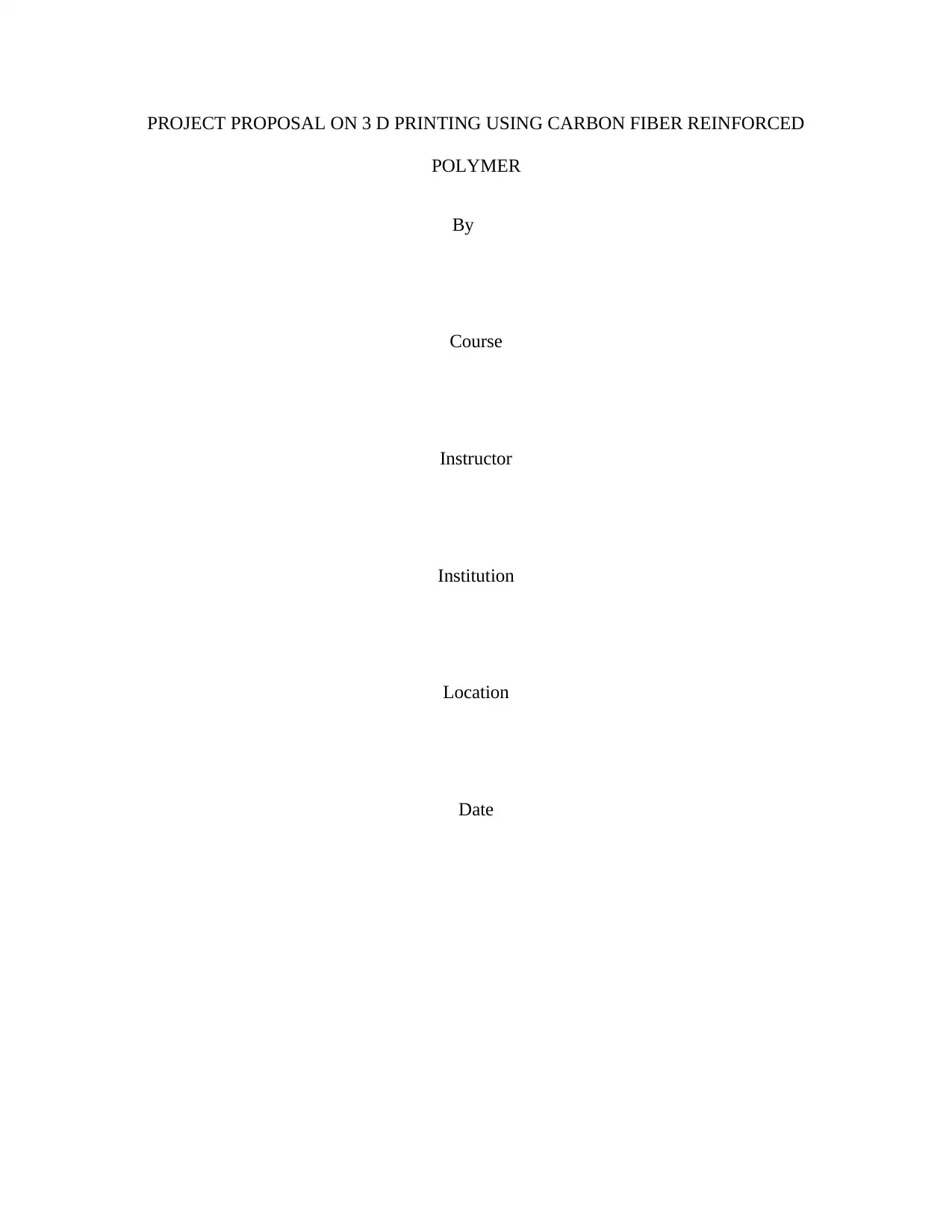
PROJECT PROPOSAL ON 3 D PRINTING USING CARBON FIBER REINFORCED
POLYMER
By
Course
Instructor
Institution
Location
Date
POLYMER
By
Course
Instructor
Institution
Location
Date
Paraphrase This Document
Need a fresh take? Get an instant paraphrase of this document with our AI Paraphraser
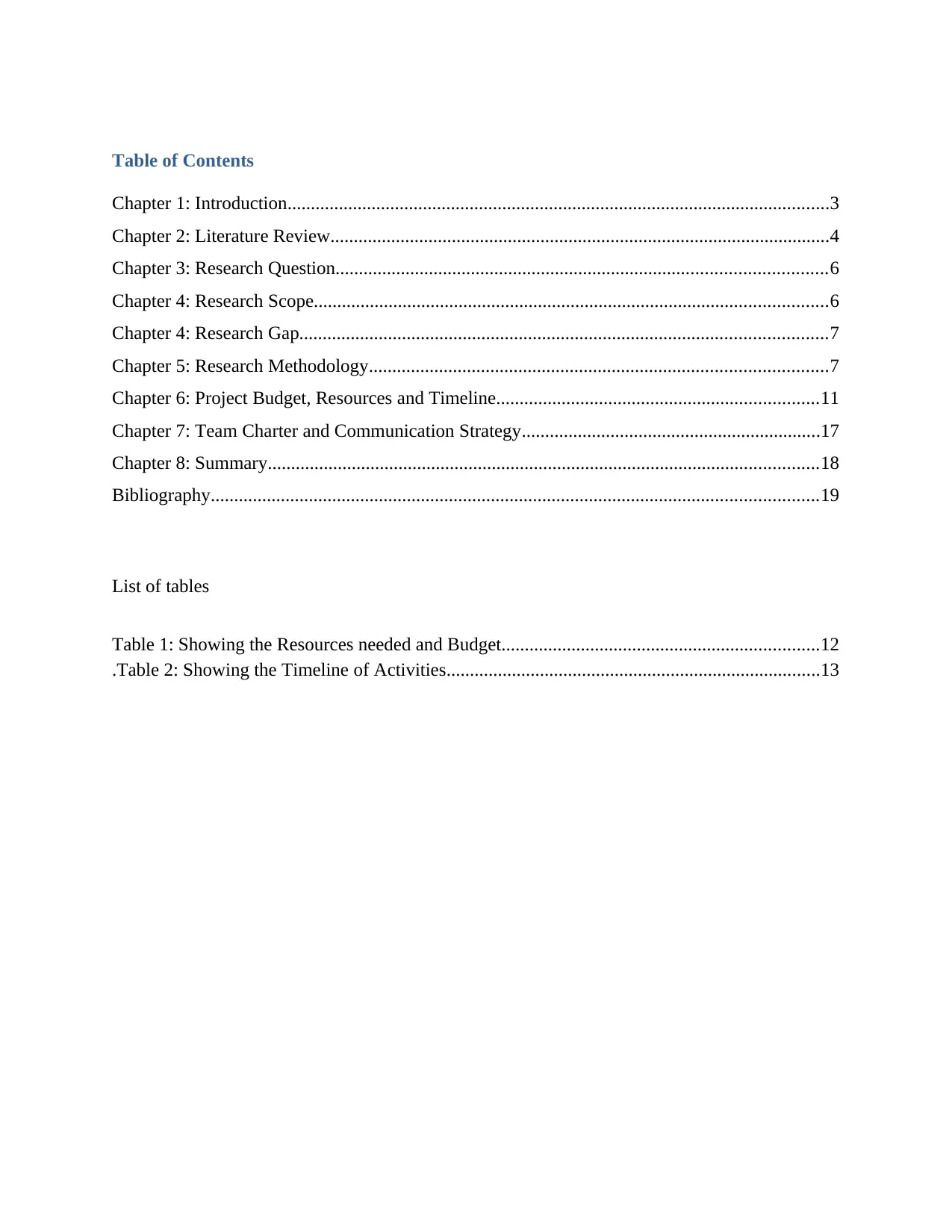
Table of Contents
Chapter 1: Introduction....................................................................................................................3
Chapter 2: Literature Review...........................................................................................................4
Chapter 3: Research Question.........................................................................................................6
Chapter 4: Research Scope..............................................................................................................6
Chapter 4: Research Gap.................................................................................................................7
Chapter 5: Research Methodology..................................................................................................7
Chapter 6: Project Budget, Resources and Timeline.....................................................................11
Chapter 7: Team Charter and Communication Strategy................................................................17
Chapter 8: Summary......................................................................................................................18
Bibliography..................................................................................................................................19
List of tables
Table 1: Showing the Resources needed and Budget....................................................................12
.Table 2: Showing the Timeline of Activities................................................................................13
Chapter 1: Introduction....................................................................................................................3
Chapter 2: Literature Review...........................................................................................................4
Chapter 3: Research Question.........................................................................................................6
Chapter 4: Research Scope..............................................................................................................6
Chapter 4: Research Gap.................................................................................................................7
Chapter 5: Research Methodology..................................................................................................7
Chapter 6: Project Budget, Resources and Timeline.....................................................................11
Chapter 7: Team Charter and Communication Strategy................................................................17
Chapter 8: Summary......................................................................................................................18
Bibliography..................................................................................................................................19
List of tables
Table 1: Showing the Resources needed and Budget....................................................................12
.Table 2: Showing the Timeline of Activities................................................................................13
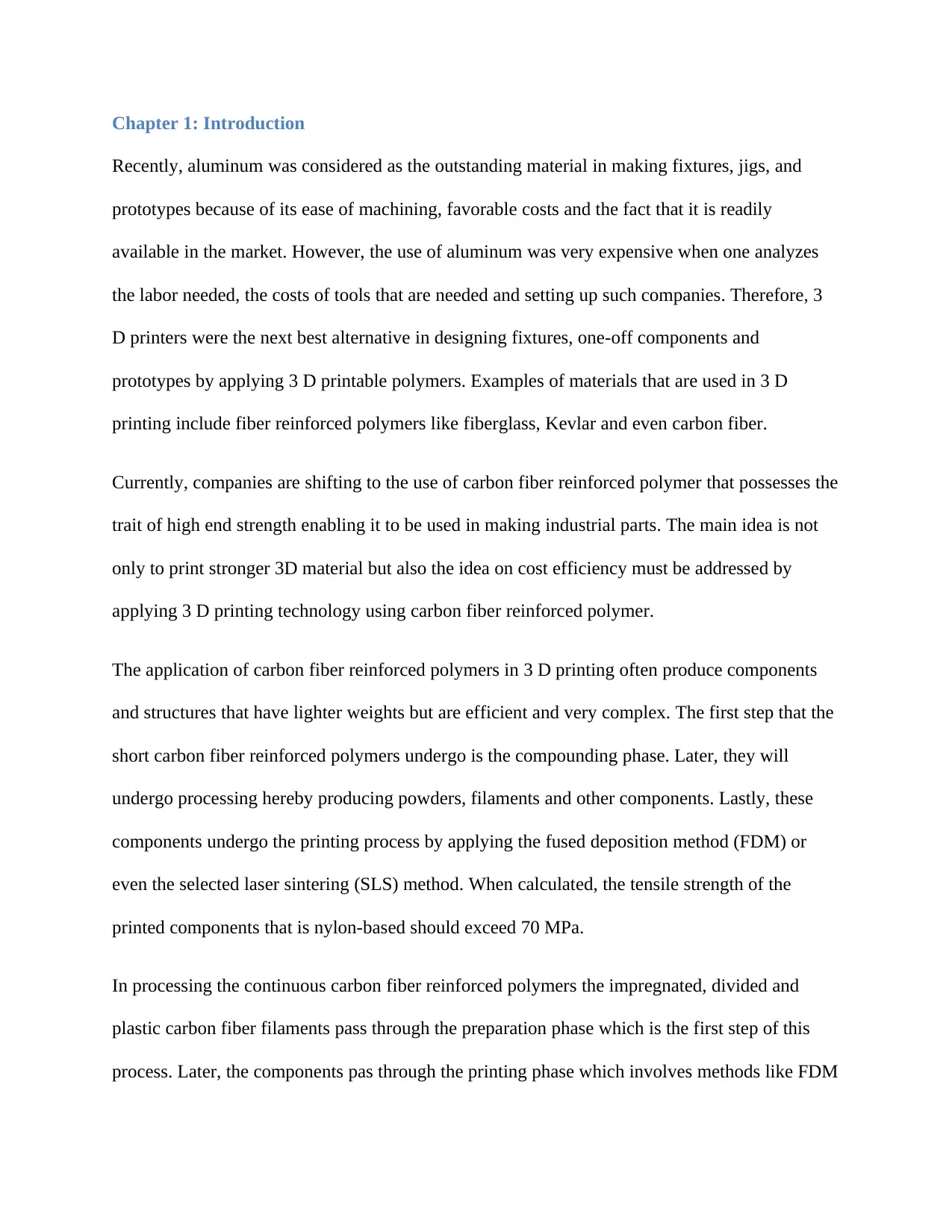
Chapter 1: Introduction
Recently, aluminum was considered as the outstanding material in making fixtures, jigs, and
prototypes because of its ease of machining, favorable costs and the fact that it is readily
available in the market. However, the use of aluminum was very expensive when one analyzes
the labor needed, the costs of tools that are needed and setting up such companies. Therefore, 3
D printers were the next best alternative in designing fixtures, one-off components and
prototypes by applying 3 D printable polymers. Examples of materials that are used in 3 D
printing include fiber reinforced polymers like fiberglass, Kevlar and even carbon fiber.
Currently, companies are shifting to the use of carbon fiber reinforced polymer that possesses the
trait of high end strength enabling it to be used in making industrial parts. The main idea is not
only to print stronger 3D material but also the idea on cost efficiency must be addressed by
applying 3 D printing technology using carbon fiber reinforced polymer.
The application of carbon fiber reinforced polymers in 3 D printing often produce components
and structures that have lighter weights but are efficient and very complex. The first step that the
short carbon fiber reinforced polymers undergo is the compounding phase. Later, they will
undergo processing hereby producing powders, filaments and other components. Lastly, these
components undergo the printing process by applying the fused deposition method (FDM) or
even the selected laser sintering (SLS) method. When calculated, the tensile strength of the
printed components that is nylon-based should exceed 70 MPa.
In processing the continuous carbon fiber reinforced polymers the impregnated, divided and
plastic carbon fiber filaments pass through the preparation phase which is the first step of this
process. Later, the components pas through the printing phase which involves methods like FDM
Recently, aluminum was considered as the outstanding material in making fixtures, jigs, and
prototypes because of its ease of machining, favorable costs and the fact that it is readily
available in the market. However, the use of aluminum was very expensive when one analyzes
the labor needed, the costs of tools that are needed and setting up such companies. Therefore, 3
D printers were the next best alternative in designing fixtures, one-off components and
prototypes by applying 3 D printable polymers. Examples of materials that are used in 3 D
printing include fiber reinforced polymers like fiberglass, Kevlar and even carbon fiber.
Currently, companies are shifting to the use of carbon fiber reinforced polymer that possesses the
trait of high end strength enabling it to be used in making industrial parts. The main idea is not
only to print stronger 3D material but also the idea on cost efficiency must be addressed by
applying 3 D printing technology using carbon fiber reinforced polymer.
The application of carbon fiber reinforced polymers in 3 D printing often produce components
and structures that have lighter weights but are efficient and very complex. The first step that the
short carbon fiber reinforced polymers undergo is the compounding phase. Later, they will
undergo processing hereby producing powders, filaments and other components. Lastly, these
components undergo the printing process by applying the fused deposition method (FDM) or
even the selected laser sintering (SLS) method. When calculated, the tensile strength of the
printed components that is nylon-based should exceed 70 MPa.
In processing the continuous carbon fiber reinforced polymers the impregnated, divided and
plastic carbon fiber filaments pass through the preparation phase which is the first step of this
process. Later, the components pas through the printing phase which involves methods like FDM
⊘ This is a preview!⊘
Do you want full access?
Subscribe today to unlock all pages.

Trusted by 1+ million students worldwide
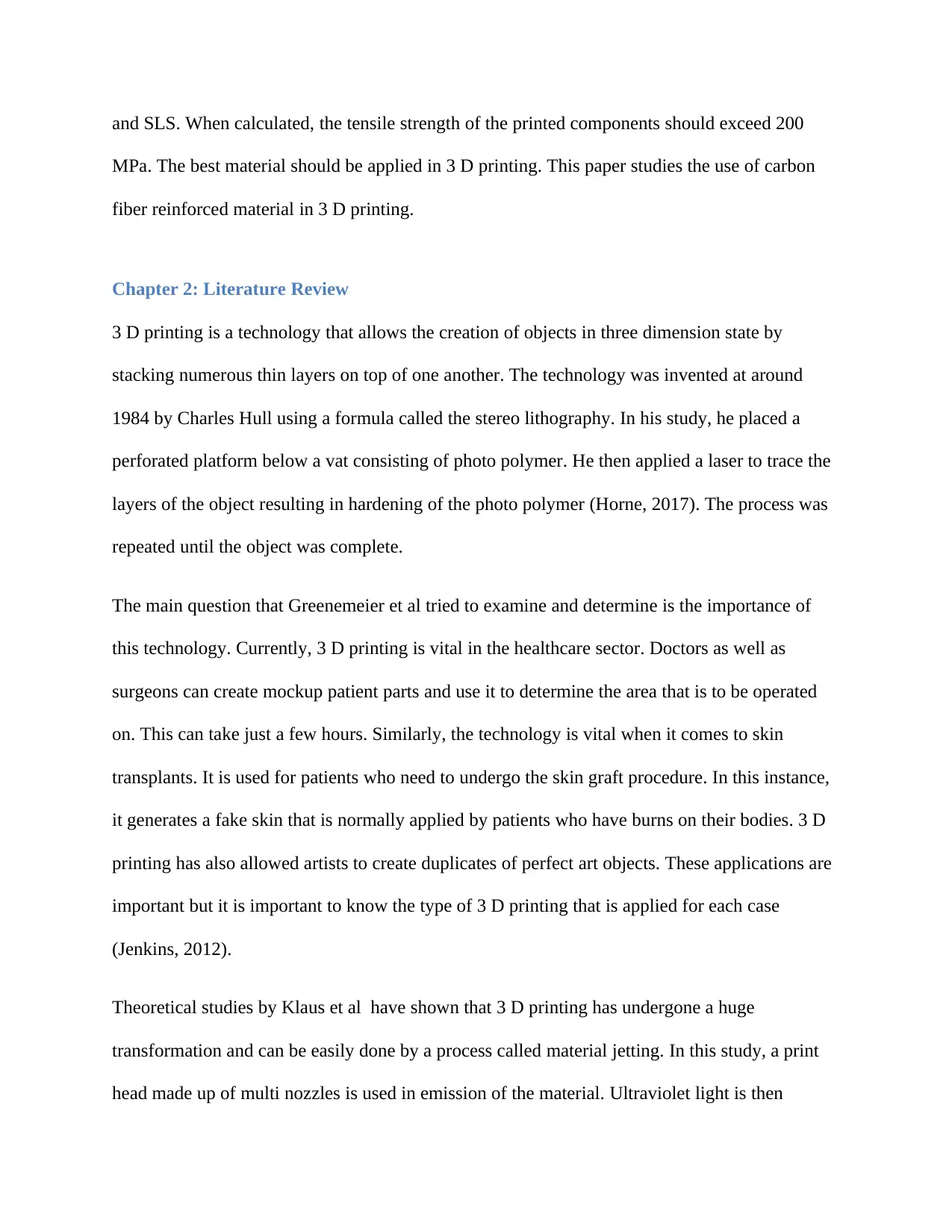
and SLS. When calculated, the tensile strength of the printed components should exceed 200
MPa. The best material should be applied in 3 D printing. This paper studies the use of carbon
fiber reinforced material in 3 D printing.
Chapter 2: Literature Review
3 D printing is a technology that allows the creation of objects in three dimension state by
stacking numerous thin layers on top of one another. The technology was invented at around
1984 by Charles Hull using a formula called the stereo lithography. In his study, he placed a
perforated platform below a vat consisting of photo polymer. He then applied a laser to trace the
layers of the object resulting in hardening of the photo polymer (Horne, 2017). The process was
repeated until the object was complete.
The main question that Greenemeier et al tried to examine and determine is the importance of
this technology. Currently, 3 D printing is vital in the healthcare sector. Doctors as well as
surgeons can create mockup patient parts and use it to determine the area that is to be operated
on. This can take just a few hours. Similarly, the technology is vital when it comes to skin
transplants. It is used for patients who need to undergo the skin graft procedure. In this instance,
it generates a fake skin that is normally applied by patients who have burns on their bodies. 3 D
printing has also allowed artists to create duplicates of perfect art objects. These applications are
important but it is important to know the type of 3 D printing that is applied for each case
(Jenkins, 2012).
Theoretical studies by Klaus et al have shown that 3 D printing has undergone a huge
transformation and can be easily done by a process called material jetting. In this study, a print
head made up of multi nozzles is used in emission of the material. Ultraviolet light is then
MPa. The best material should be applied in 3 D printing. This paper studies the use of carbon
fiber reinforced material in 3 D printing.
Chapter 2: Literature Review
3 D printing is a technology that allows the creation of objects in three dimension state by
stacking numerous thin layers on top of one another. The technology was invented at around
1984 by Charles Hull using a formula called the stereo lithography. In his study, he placed a
perforated platform below a vat consisting of photo polymer. He then applied a laser to trace the
layers of the object resulting in hardening of the photo polymer (Horne, 2017). The process was
repeated until the object was complete.
The main question that Greenemeier et al tried to examine and determine is the importance of
this technology. Currently, 3 D printing is vital in the healthcare sector. Doctors as well as
surgeons can create mockup patient parts and use it to determine the area that is to be operated
on. This can take just a few hours. Similarly, the technology is vital when it comes to skin
transplants. It is used for patients who need to undergo the skin graft procedure. In this instance,
it generates a fake skin that is normally applied by patients who have burns on their bodies. 3 D
printing has also allowed artists to create duplicates of perfect art objects. These applications are
important but it is important to know the type of 3 D printing that is applied for each case
(Jenkins, 2012).
Theoretical studies by Klaus et al have shown that 3 D printing has undergone a huge
transformation and can be easily done by a process called material jetting. In this study, a print
head made up of multi nozzles is used in emission of the material. Ultraviolet light is then
Paraphrase This Document
Need a fresh take? Get an instant paraphrase of this document with our AI Paraphraser
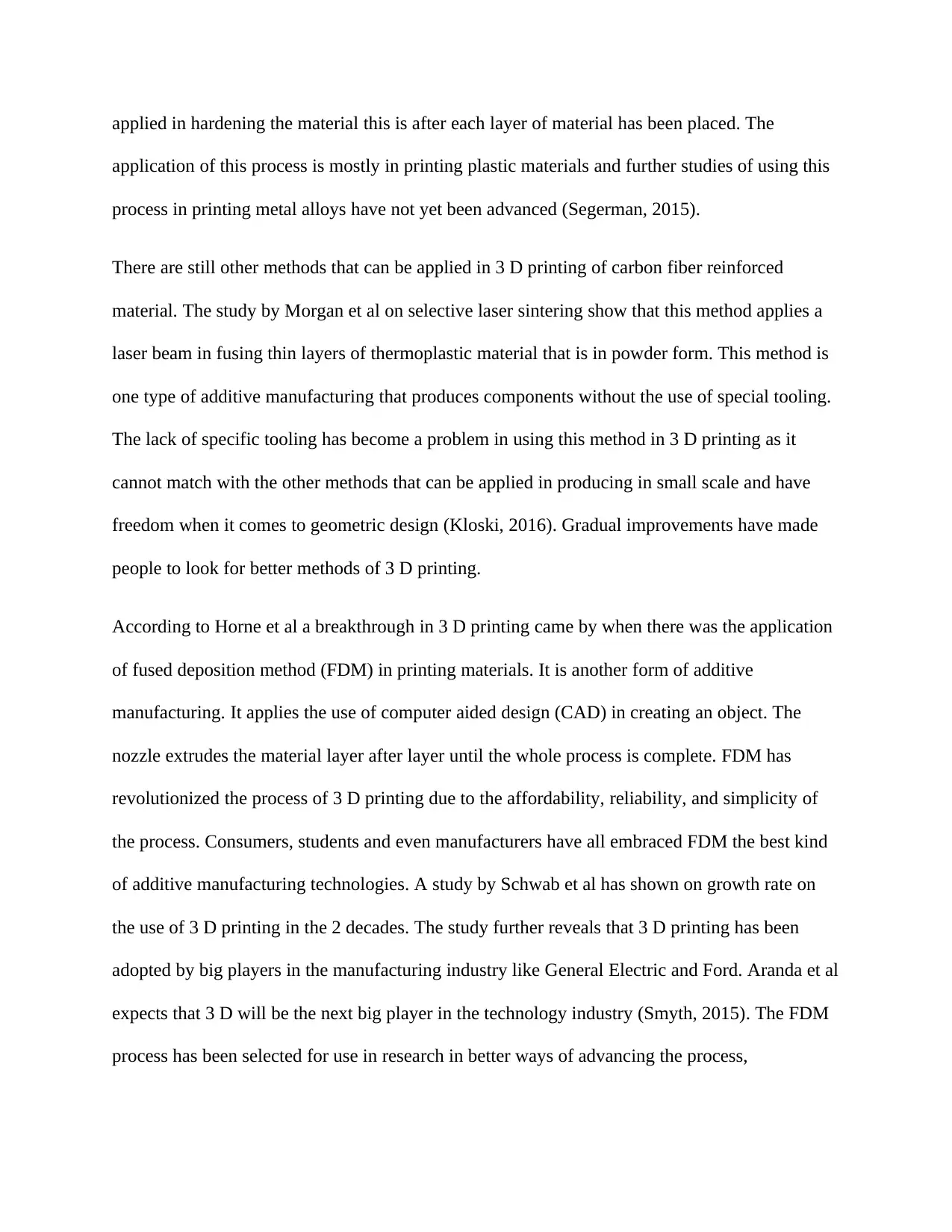
applied in hardening the material this is after each layer of material has been placed. The
application of this process is mostly in printing plastic materials and further studies of using this
process in printing metal alloys have not yet been advanced (Segerman, 2015).
There are still other methods that can be applied in 3 D printing of carbon fiber reinforced
material. The study by Morgan et al on selective laser sintering show that this method applies a
laser beam in fusing thin layers of thermoplastic material that is in powder form. This method is
one type of additive manufacturing that produces components without the use of special tooling.
The lack of specific tooling has become a problem in using this method in 3 D printing as it
cannot match with the other methods that can be applied in producing in small scale and have
freedom when it comes to geometric design (Kloski, 2016). Gradual improvements have made
people to look for better methods of 3 D printing.
According to Horne et al a breakthrough in 3 D printing came by when there was the application
of fused deposition method (FDM) in printing materials. It is another form of additive
manufacturing. It applies the use of computer aided design (CAD) in creating an object. The
nozzle extrudes the material layer after layer until the whole process is complete. FDM has
revolutionized the process of 3 D printing due to the affordability, reliability, and simplicity of
the process. Consumers, students and even manufacturers have all embraced FDM the best kind
of additive manufacturing technologies. A study by Schwab et al has shown on growth rate on
the use of 3 D printing in the 2 decades. The study further reveals that 3 D printing has been
adopted by big players in the manufacturing industry like General Electric and Ford. Aranda et al
expects that 3 D will be the next big player in the technology industry (Smyth, 2015). The FDM
process has been selected for use in research in better ways of advancing the process,
application of this process is mostly in printing plastic materials and further studies of using this
process in printing metal alloys have not yet been advanced (Segerman, 2015).
There are still other methods that can be applied in 3 D printing of carbon fiber reinforced
material. The study by Morgan et al on selective laser sintering show that this method applies a
laser beam in fusing thin layers of thermoplastic material that is in powder form. This method is
one type of additive manufacturing that produces components without the use of special tooling.
The lack of specific tooling has become a problem in using this method in 3 D printing as it
cannot match with the other methods that can be applied in producing in small scale and have
freedom when it comes to geometric design (Kloski, 2016). Gradual improvements have made
people to look for better methods of 3 D printing.
According to Horne et al a breakthrough in 3 D printing came by when there was the application
of fused deposition method (FDM) in printing materials. It is another form of additive
manufacturing. It applies the use of computer aided design (CAD) in creating an object. The
nozzle extrudes the material layer after layer until the whole process is complete. FDM has
revolutionized the process of 3 D printing due to the affordability, reliability, and simplicity of
the process. Consumers, students and even manufacturers have all embraced FDM the best kind
of additive manufacturing technologies. A study by Schwab et al has shown on growth rate on
the use of 3 D printing in the 2 decades. The study further reveals that 3 D printing has been
adopted by big players in the manufacturing industry like General Electric and Ford. Aranda et al
expects that 3 D will be the next big player in the technology industry (Smyth, 2015). The FDM
process has been selected for use in research in better ways of advancing the process,
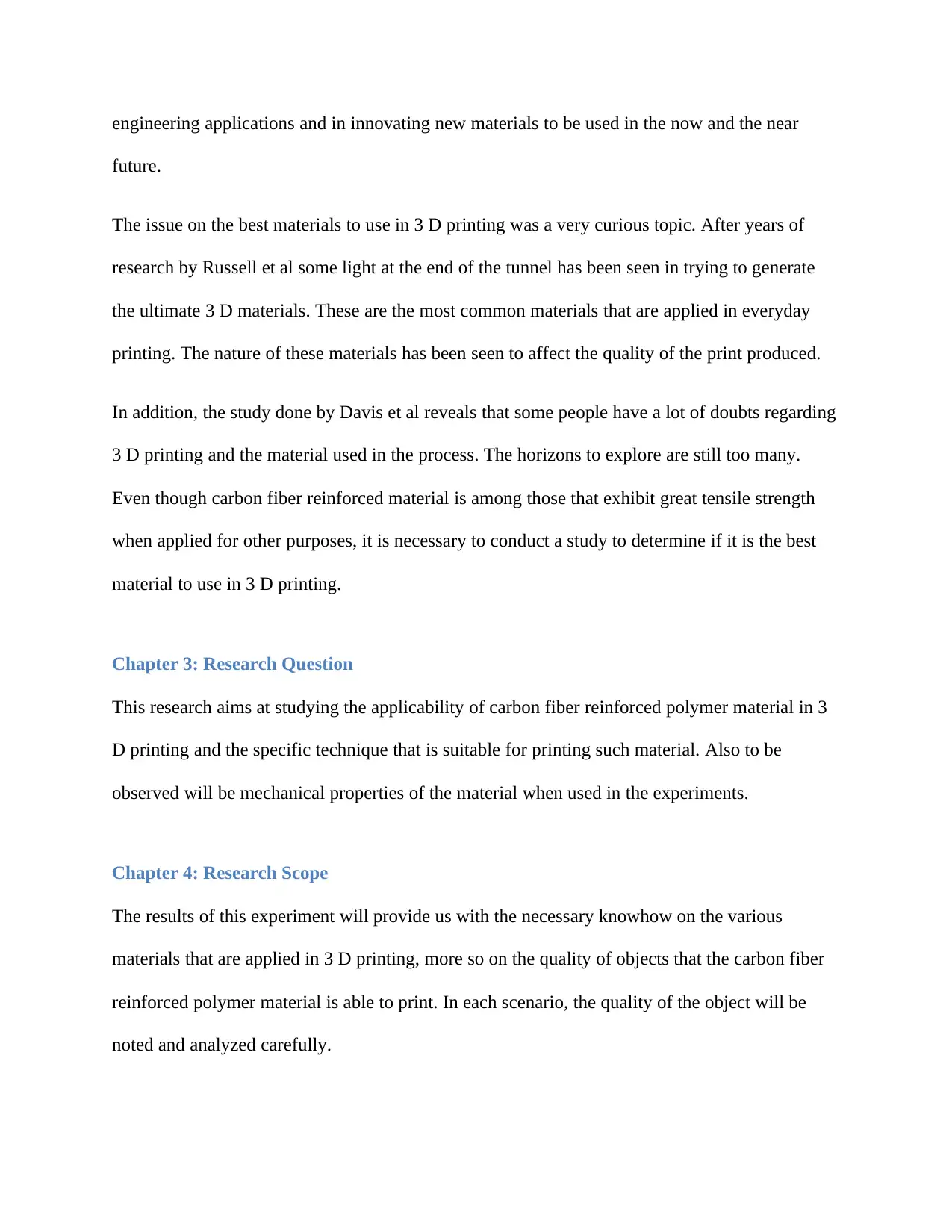
engineering applications and in innovating new materials to be used in the now and the near
future.
The issue on the best materials to use in 3 D printing was a very curious topic. After years of
research by Russell et al some light at the end of the tunnel has been seen in trying to generate
the ultimate 3 D materials. These are the most common materials that are applied in everyday
printing. The nature of these materials has been seen to affect the quality of the print produced.
In addition, the study done by Davis et al reveals that some people have a lot of doubts regarding
3 D printing and the material used in the process. The horizons to explore are still too many.
Even though carbon fiber reinforced material is among those that exhibit great tensile strength
when applied for other purposes, it is necessary to conduct a study to determine if it is the best
material to use in 3 D printing.
Chapter 3: Research Question
This research aims at studying the applicability of carbon fiber reinforced polymer material in 3
D printing and the specific technique that is suitable for printing such material. Also to be
observed will be mechanical properties of the material when used in the experiments.
Chapter 4: Research Scope
The results of this experiment will provide us with the necessary knowhow on the various
materials that are applied in 3 D printing, more so on the quality of objects that the carbon fiber
reinforced polymer material is able to print. In each scenario, the quality of the object will be
noted and analyzed carefully.
future.
The issue on the best materials to use in 3 D printing was a very curious topic. After years of
research by Russell et al some light at the end of the tunnel has been seen in trying to generate
the ultimate 3 D materials. These are the most common materials that are applied in everyday
printing. The nature of these materials has been seen to affect the quality of the print produced.
In addition, the study done by Davis et al reveals that some people have a lot of doubts regarding
3 D printing and the material used in the process. The horizons to explore are still too many.
Even though carbon fiber reinforced material is among those that exhibit great tensile strength
when applied for other purposes, it is necessary to conduct a study to determine if it is the best
material to use in 3 D printing.
Chapter 3: Research Question
This research aims at studying the applicability of carbon fiber reinforced polymer material in 3
D printing and the specific technique that is suitable for printing such material. Also to be
observed will be mechanical properties of the material when used in the experiments.
Chapter 4: Research Scope
The results of this experiment will provide us with the necessary knowhow on the various
materials that are applied in 3 D printing, more so on the quality of objects that the carbon fiber
reinforced polymer material is able to print. In each scenario, the quality of the object will be
noted and analyzed carefully.
⊘ This is a preview!⊘
Do you want full access?
Subscribe today to unlock all pages.

Trusted by 1+ million students worldwide
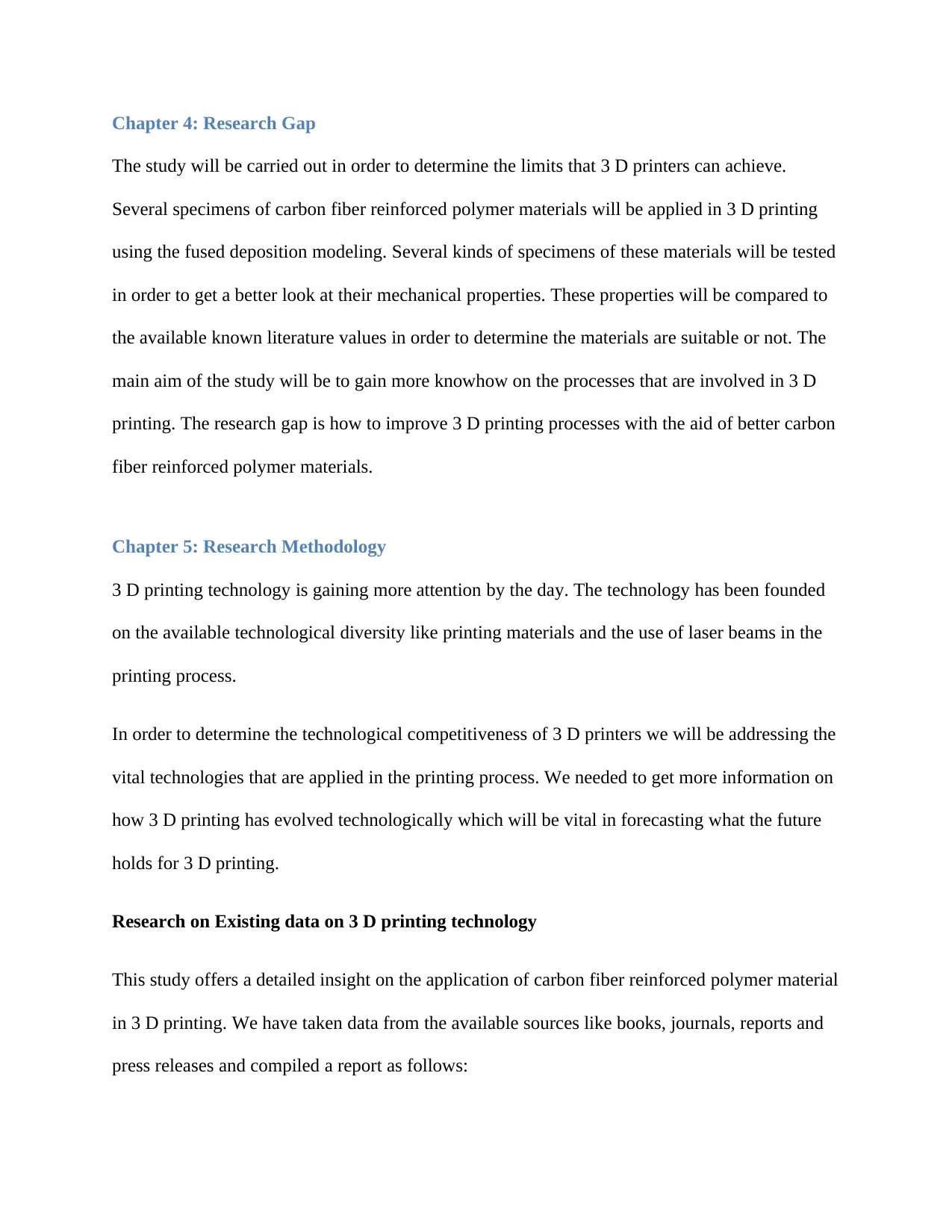
Chapter 4: Research Gap
The study will be carried out in order to determine the limits that 3 D printers can achieve.
Several specimens of carbon fiber reinforced polymer materials will be applied in 3 D printing
using the fused deposition modeling. Several kinds of specimens of these materials will be tested
in order to get a better look at their mechanical properties. These properties will be compared to
the available known literature values in order to determine the materials are suitable or not. The
main aim of the study will be to gain more knowhow on the processes that are involved in 3 D
printing. The research gap is how to improve 3 D printing processes with the aid of better carbon
fiber reinforced polymer materials.
Chapter 5: Research Methodology
3 D printing technology is gaining more attention by the day. The technology has been founded
on the available technological diversity like printing materials and the use of laser beams in the
printing process.
In order to determine the technological competitiveness of 3 D printers we will be addressing the
vital technologies that are applied in the printing process. We needed to get more information on
how 3 D printing has evolved technologically which will be vital in forecasting what the future
holds for 3 D printing.
Research on Existing data on 3 D printing technology
This study offers a detailed insight on the application of carbon fiber reinforced polymer material
in 3 D printing. We have taken data from the available sources like books, journals, reports and
press releases and compiled a report as follows:
The study will be carried out in order to determine the limits that 3 D printers can achieve.
Several specimens of carbon fiber reinforced polymer materials will be applied in 3 D printing
using the fused deposition modeling. Several kinds of specimens of these materials will be tested
in order to get a better look at their mechanical properties. These properties will be compared to
the available known literature values in order to determine the materials are suitable or not. The
main aim of the study will be to gain more knowhow on the processes that are involved in 3 D
printing. The research gap is how to improve 3 D printing processes with the aid of better carbon
fiber reinforced polymer materials.
Chapter 5: Research Methodology
3 D printing technology is gaining more attention by the day. The technology has been founded
on the available technological diversity like printing materials and the use of laser beams in the
printing process.
In order to determine the technological competitiveness of 3 D printers we will be addressing the
vital technologies that are applied in the printing process. We needed to get more information on
how 3 D printing has evolved technologically which will be vital in forecasting what the future
holds for 3 D printing.
Research on Existing data on 3 D printing technology
This study offers a detailed insight on the application of carbon fiber reinforced polymer material
in 3 D printing. We have taken data from the available sources like books, journals, reports and
press releases and compiled a report as follows:
Paraphrase This Document
Need a fresh take? Get an instant paraphrase of this document with our AI Paraphraser
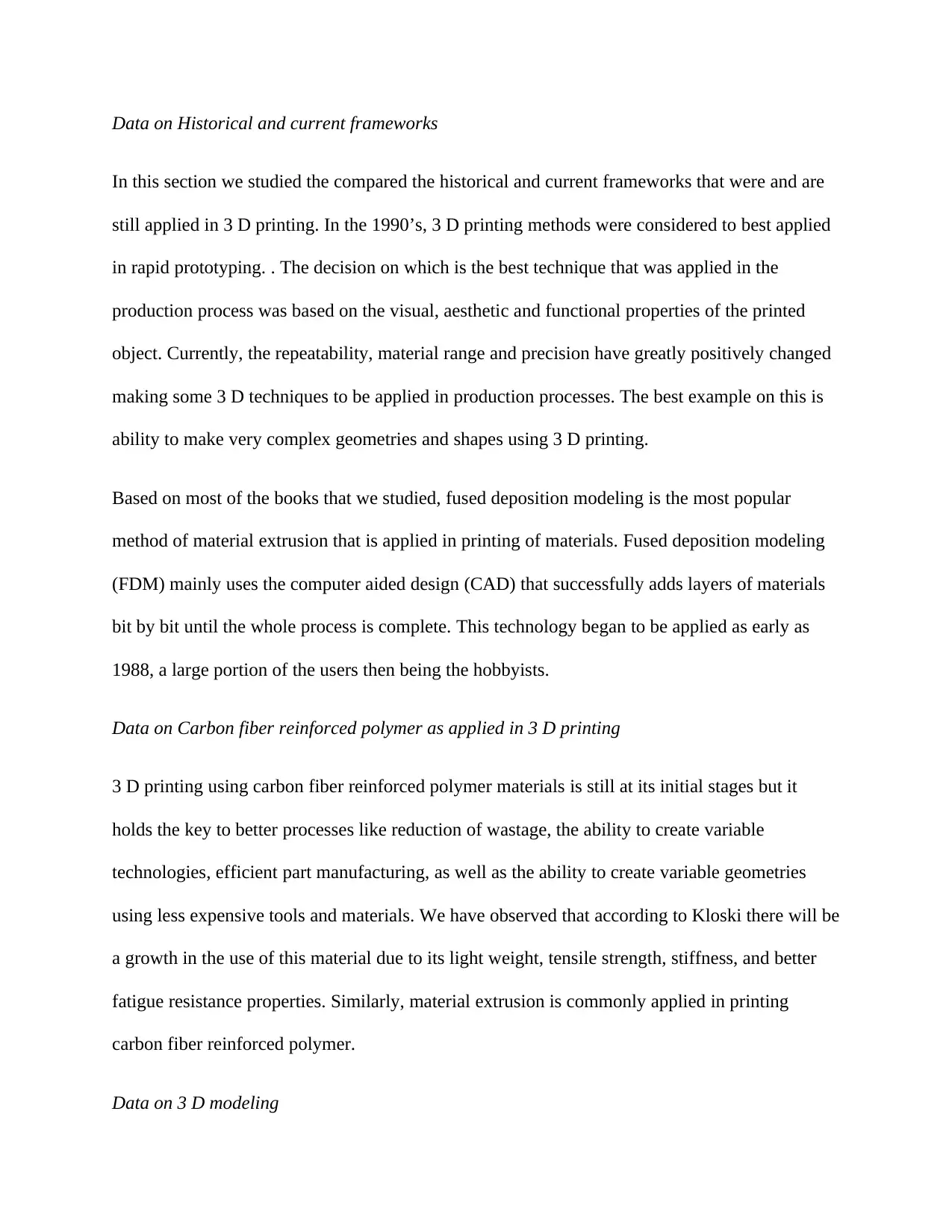
Data on Historical and current frameworks
In this section we studied the compared the historical and current frameworks that were and are
still applied in 3 D printing. In the 1990’s, 3 D printing methods were considered to best applied
in rapid prototyping. . The decision on which is the best technique that was applied in the
production process was based on the visual, aesthetic and functional properties of the printed
object. Currently, the repeatability, material range and precision have greatly positively changed
making some 3 D techniques to be applied in production processes. The best example on this is
ability to make very complex geometries and shapes using 3 D printing.
Based on most of the books that we studied, fused deposition modeling is the most popular
method of material extrusion that is applied in printing of materials. Fused deposition modeling
(FDM) mainly uses the computer aided design (CAD) that successfully adds layers of materials
bit by bit until the whole process is complete. This technology began to be applied as early as
1988, a large portion of the users then being the hobbyists.
Data on Carbon fiber reinforced polymer as applied in 3 D printing
3 D printing using carbon fiber reinforced polymer materials is still at its initial stages but it
holds the key to better processes like reduction of wastage, the ability to create variable
technologies, efficient part manufacturing, as well as the ability to create variable geometries
using less expensive tools and materials. We have observed that according to Kloski there will be
a growth in the use of this material due to its light weight, tensile strength, stiffness, and better
fatigue resistance properties. Similarly, material extrusion is commonly applied in printing
carbon fiber reinforced polymer.
Data on 3 D modeling
In this section we studied the compared the historical and current frameworks that were and are
still applied in 3 D printing. In the 1990’s, 3 D printing methods were considered to best applied
in rapid prototyping. . The decision on which is the best technique that was applied in the
production process was based on the visual, aesthetic and functional properties of the printed
object. Currently, the repeatability, material range and precision have greatly positively changed
making some 3 D techniques to be applied in production processes. The best example on this is
ability to make very complex geometries and shapes using 3 D printing.
Based on most of the books that we studied, fused deposition modeling is the most popular
method of material extrusion that is applied in printing of materials. Fused deposition modeling
(FDM) mainly uses the computer aided design (CAD) that successfully adds layers of materials
bit by bit until the whole process is complete. This technology began to be applied as early as
1988, a large portion of the users then being the hobbyists.
Data on Carbon fiber reinforced polymer as applied in 3 D printing
3 D printing using carbon fiber reinforced polymer materials is still at its initial stages but it
holds the key to better processes like reduction of wastage, the ability to create variable
technologies, efficient part manufacturing, as well as the ability to create variable geometries
using less expensive tools and materials. We have observed that according to Kloski there will be
a growth in the use of this material due to its light weight, tensile strength, stiffness, and better
fatigue resistance properties. Similarly, material extrusion is commonly applied in printing
carbon fiber reinforced polymer.
Data on 3 D modeling
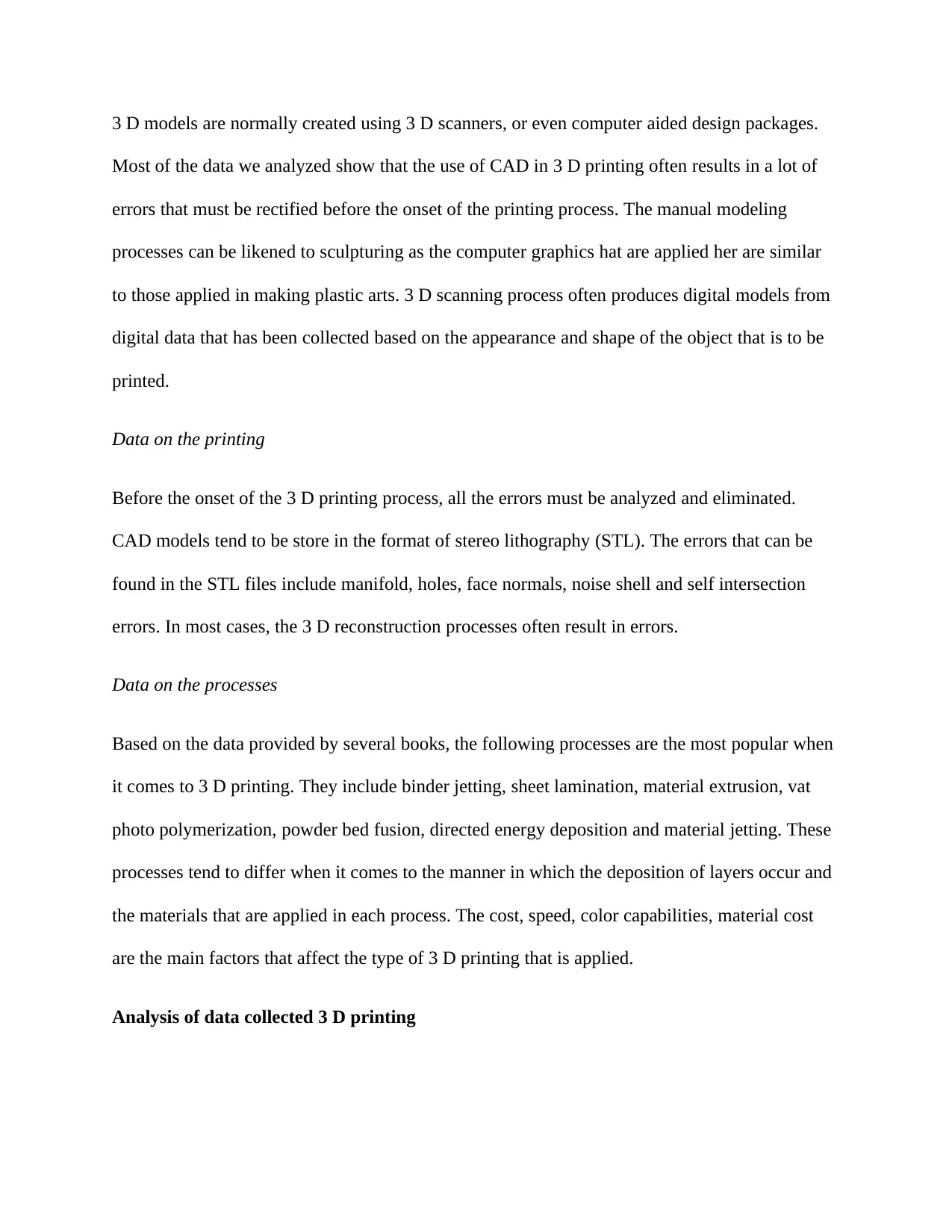
3 D models are normally created using 3 D scanners, or even computer aided design packages.
Most of the data we analyzed show that the use of CAD in 3 D printing often results in a lot of
errors that must be rectified before the onset of the printing process. The manual modeling
processes can be likened to sculpturing as the computer graphics hat are applied her are similar
to those applied in making plastic arts. 3 D scanning process often produces digital models from
digital data that has been collected based on the appearance and shape of the object that is to be
printed.
Data on the printing
Before the onset of the 3 D printing process, all the errors must be analyzed and eliminated.
CAD models tend to be store in the format of stereo lithography (STL). The errors that can be
found in the STL files include manifold, holes, face normals, noise shell and self intersection
errors. In most cases, the 3 D reconstruction processes often result in errors.
Data on the processes
Based on the data provided by several books, the following processes are the most popular when
it comes to 3 D printing. They include binder jetting, sheet lamination, material extrusion, vat
photo polymerization, powder bed fusion, directed energy deposition and material jetting. These
processes tend to differ when it comes to the manner in which the deposition of layers occur and
the materials that are applied in each process. The cost, speed, color capabilities, material cost
are the main factors that affect the type of 3 D printing that is applied.
Analysis of data collected 3 D printing
Most of the data we analyzed show that the use of CAD in 3 D printing often results in a lot of
errors that must be rectified before the onset of the printing process. The manual modeling
processes can be likened to sculpturing as the computer graphics hat are applied her are similar
to those applied in making plastic arts. 3 D scanning process often produces digital models from
digital data that has been collected based on the appearance and shape of the object that is to be
printed.
Data on the printing
Before the onset of the 3 D printing process, all the errors must be analyzed and eliminated.
CAD models tend to be store in the format of stereo lithography (STL). The errors that can be
found in the STL files include manifold, holes, face normals, noise shell and self intersection
errors. In most cases, the 3 D reconstruction processes often result in errors.
Data on the processes
Based on the data provided by several books, the following processes are the most popular when
it comes to 3 D printing. They include binder jetting, sheet lamination, material extrusion, vat
photo polymerization, powder bed fusion, directed energy deposition and material jetting. These
processes tend to differ when it comes to the manner in which the deposition of layers occur and
the materials that are applied in each process. The cost, speed, color capabilities, material cost
are the main factors that affect the type of 3 D printing that is applied.
Analysis of data collected 3 D printing
⊘ This is a preview!⊘
Do you want full access?
Subscribe today to unlock all pages.

Trusted by 1+ million students worldwide
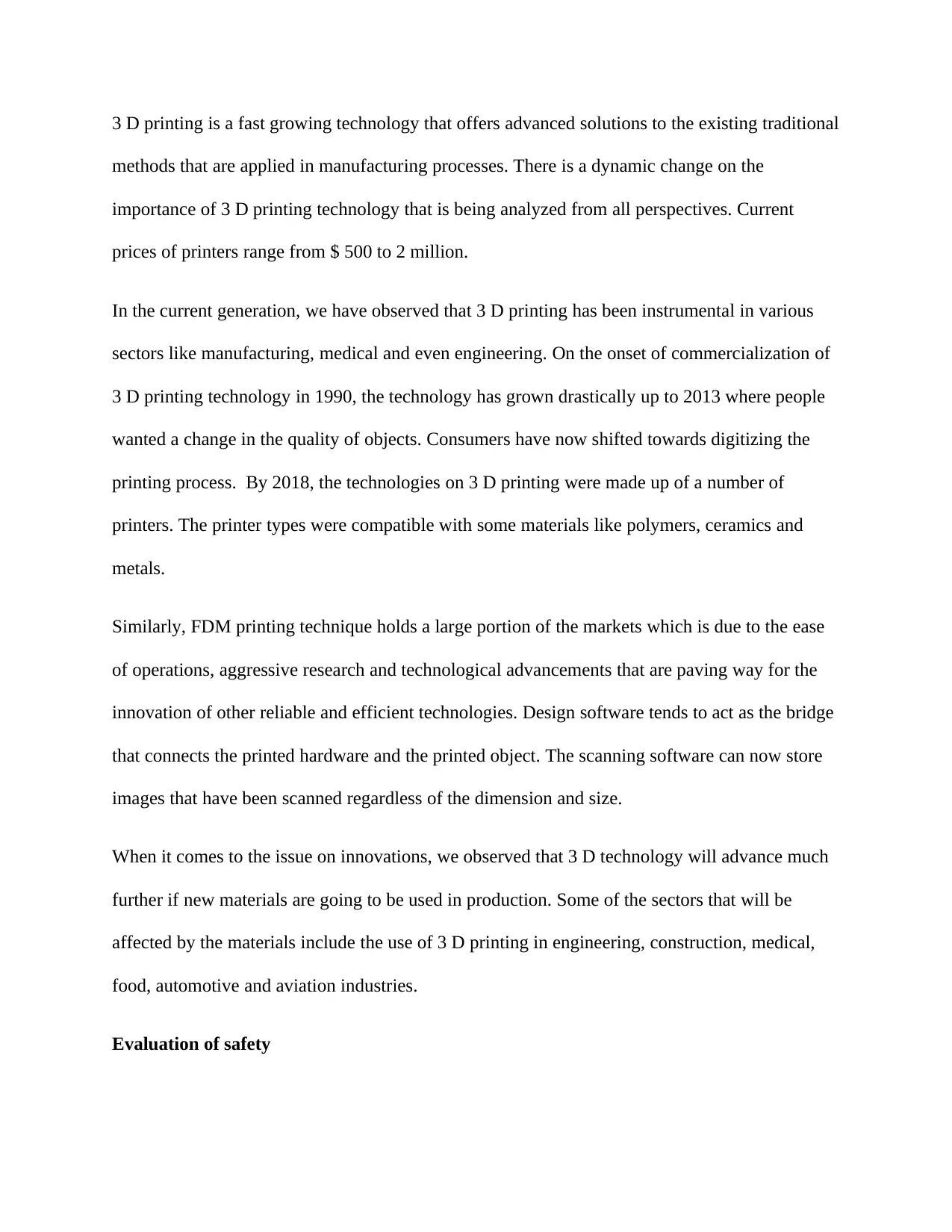
3 D printing is a fast growing technology that offers advanced solutions to the existing traditional
methods that are applied in manufacturing processes. There is a dynamic change on the
importance of 3 D printing technology that is being analyzed from all perspectives. Current
prices of printers range from $ 500 to 2 million.
In the current generation, we have observed that 3 D printing has been instrumental in various
sectors like manufacturing, medical and even engineering. On the onset of commercialization of
3 D printing technology in 1990, the technology has grown drastically up to 2013 where people
wanted a change in the quality of objects. Consumers have now shifted towards digitizing the
printing process. By 2018, the technologies on 3 D printing were made up of a number of
printers. The printer types were compatible with some materials like polymers, ceramics and
metals.
Similarly, FDM printing technique holds a large portion of the markets which is due to the ease
of operations, aggressive research and technological advancements that are paving way for the
innovation of other reliable and efficient technologies. Design software tends to act as the bridge
that connects the printed hardware and the printed object. The scanning software can now store
images that have been scanned regardless of the dimension and size.
When it comes to the issue on innovations, we observed that 3 D technology will advance much
further if new materials are going to be used in production. Some of the sectors that will be
affected by the materials include the use of 3 D printing in engineering, construction, medical,
food, automotive and aviation industries.
Evaluation of safety
methods that are applied in manufacturing processes. There is a dynamic change on the
importance of 3 D printing technology that is being analyzed from all perspectives. Current
prices of printers range from $ 500 to 2 million.
In the current generation, we have observed that 3 D printing has been instrumental in various
sectors like manufacturing, medical and even engineering. On the onset of commercialization of
3 D printing technology in 1990, the technology has grown drastically up to 2013 where people
wanted a change in the quality of objects. Consumers have now shifted towards digitizing the
printing process. By 2018, the technologies on 3 D printing were made up of a number of
printers. The printer types were compatible with some materials like polymers, ceramics and
metals.
Similarly, FDM printing technique holds a large portion of the markets which is due to the ease
of operations, aggressive research and technological advancements that are paving way for the
innovation of other reliable and efficient technologies. Design software tends to act as the bridge
that connects the printed hardware and the printed object. The scanning software can now store
images that have been scanned regardless of the dimension and size.
When it comes to the issue on innovations, we observed that 3 D technology will advance much
further if new materials are going to be used in production. Some of the sectors that will be
affected by the materials include the use of 3 D printing in engineering, construction, medical,
food, automotive and aviation industries.
Evaluation of safety
Paraphrase This Document
Need a fresh take? Get an instant paraphrase of this document with our AI Paraphraser
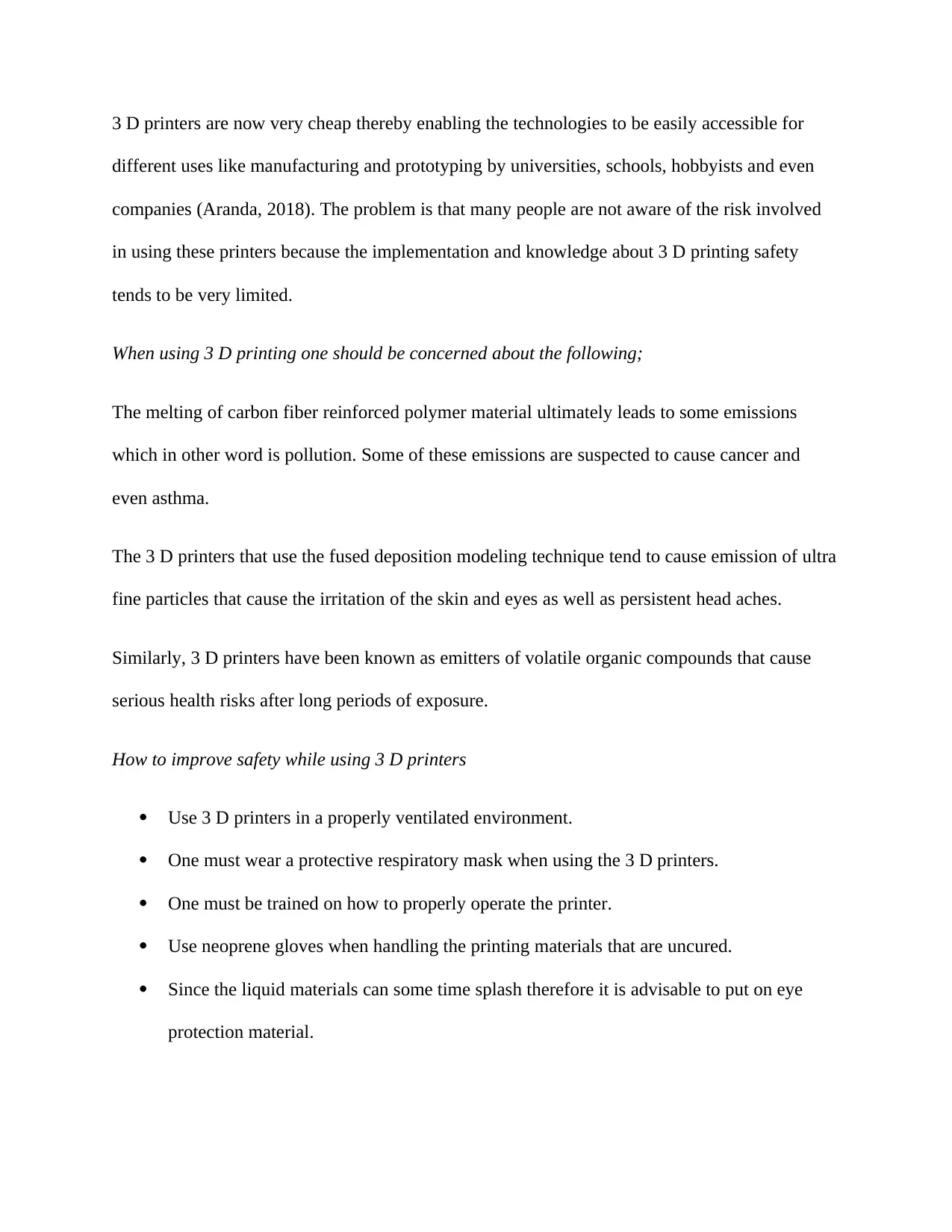
3 D printers are now very cheap thereby enabling the technologies to be easily accessible for
different uses like manufacturing and prototyping by universities, schools, hobbyists and even
companies (Aranda, 2018). The problem is that many people are not aware of the risk involved
in using these printers because the implementation and knowledge about 3 D printing safety
tends to be very limited.
When using 3 D printing one should be concerned about the following;
The melting of carbon fiber reinforced polymer material ultimately leads to some emissions
which in other word is pollution. Some of these emissions are suspected to cause cancer and
even asthma.
The 3 D printers that use the fused deposition modeling technique tend to cause emission of ultra
fine particles that cause the irritation of the skin and eyes as well as persistent head aches.
Similarly, 3 D printers have been known as emitters of volatile organic compounds that cause
serious health risks after long periods of exposure.
How to improve safety while using 3 D printers
Use 3 D printers in a properly ventilated environment.
One must wear a protective respiratory mask when using the 3 D printers.
One must be trained on how to properly operate the printer.
Use neoprene gloves when handling the printing materials that are uncured.
Since the liquid materials can some time splash therefore it is advisable to put on eye
protection material.
different uses like manufacturing and prototyping by universities, schools, hobbyists and even
companies (Aranda, 2018). The problem is that many people are not aware of the risk involved
in using these printers because the implementation and knowledge about 3 D printing safety
tends to be very limited.
When using 3 D printing one should be concerned about the following;
The melting of carbon fiber reinforced polymer material ultimately leads to some emissions
which in other word is pollution. Some of these emissions are suspected to cause cancer and
even asthma.
The 3 D printers that use the fused deposition modeling technique tend to cause emission of ultra
fine particles that cause the irritation of the skin and eyes as well as persistent head aches.
Similarly, 3 D printers have been known as emitters of volatile organic compounds that cause
serious health risks after long periods of exposure.
How to improve safety while using 3 D printers
Use 3 D printers in a properly ventilated environment.
One must wear a protective respiratory mask when using the 3 D printers.
One must be trained on how to properly operate the printer.
Use neoprene gloves when handling the printing materials that are uncured.
Since the liquid materials can some time splash therefore it is advisable to put on eye
protection material.
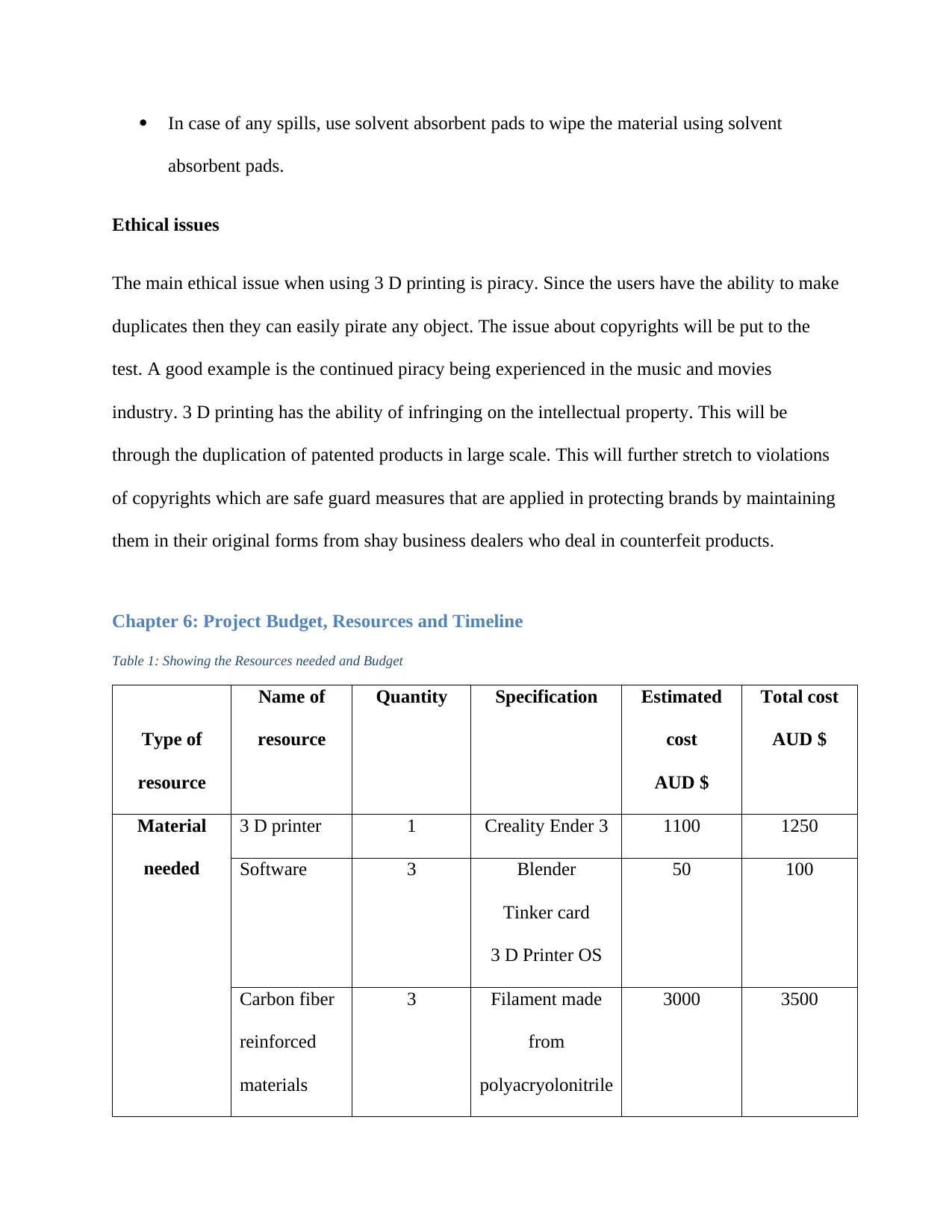
In case of any spills, use solvent absorbent pads to wipe the material using solvent
absorbent pads.
Ethical issues
The main ethical issue when using 3 D printing is piracy. Since the users have the ability to make
duplicates then they can easily pirate any object. The issue about copyrights will be put to the
test. A good example is the continued piracy being experienced in the music and movies
industry. 3 D printing has the ability of infringing on the intellectual property. This will be
through the duplication of patented products in large scale. This will further stretch to violations
of copyrights which are safe guard measures that are applied in protecting brands by maintaining
them in their original forms from shay business dealers who deal in counterfeit products.
Chapter 6: Project Budget, Resources and Timeline
Table 1: Showing the Resources needed and Budget
Type of
resource
Name of
resource
Quantity Specification Estimated
cost
AUD $
Total cost
AUD $
Material
needed
3 D printer 1 Creality Ender 3 1100 1250
Software 3 Blender
Tinker card
3 D Printer OS
50 100
Carbon fiber
reinforced
materials
3 Filament made
from
polyacryolonitrile
3000 3500
absorbent pads.
Ethical issues
The main ethical issue when using 3 D printing is piracy. Since the users have the ability to make
duplicates then they can easily pirate any object. The issue about copyrights will be put to the
test. A good example is the continued piracy being experienced in the music and movies
industry. 3 D printing has the ability of infringing on the intellectual property. This will be
through the duplication of patented products in large scale. This will further stretch to violations
of copyrights which are safe guard measures that are applied in protecting brands by maintaining
them in their original forms from shay business dealers who deal in counterfeit products.
Chapter 6: Project Budget, Resources and Timeline
Table 1: Showing the Resources needed and Budget
Type of
resource
Name of
resource
Quantity Specification Estimated
cost
AUD $
Total cost
AUD $
Material
needed
3 D printer 1 Creality Ender 3 1100 1250
Software 3 Blender
Tinker card
3 D Printer OS
50 100
Carbon fiber
reinforced
materials
3 Filament made
from
polyacryolonitrile
3000 3500
⊘ This is a preview!⊘
Do you want full access?
Subscribe today to unlock all pages.

Trusted by 1+ million students worldwide
1 out of 23
Your All-in-One AI-Powered Toolkit for Academic Success.
+13062052269
info@desklib.com
Available 24*7 on WhatsApp / Email
![[object Object]](/_next/static/media/star-bottom.7253800d.svg)
Unlock your academic potential
Copyright © 2020–2025 A2Z Services. All Rights Reserved. Developed and managed by ZUCOL.
